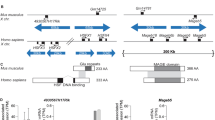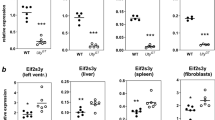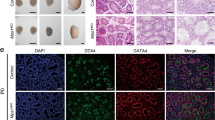Abstract
In mouse and man, deletions of specific regions of the Y chromosome have been linked to early failure of spermatogenesis and consequent sterility; the Y chromosomal gene(s) with this essential early role in spermatogenesis have not been identified. The partial deletion of the mouse Y short arm (the Sxrb deletion) that occurred when Tp(Y)1CtSxr-b (hereafter Sxrb) arose from Tp(Y)1CTSxr-b (hereafter Sxra) defines Spy, a Y chromosomal factor essential for normal spermatogonial proliferation1,2,3. Molecular analysis has identified six genes that lie within the deletion: Ube1y1 (refs. 4,5), Smcy6, Uty7, Usp9y (also known as Dffry)8, Eif2s3y (also known as Eif-2γy)9 and Dby10; all have closely similar X-encoded homologs. Of the Y-encoded genes, Ube1y1 and Dby have been considered strong candidates for mouse Spy function4,5,10,11, whereas Smcy has been effectively ruled out as a candidate12. There is no Ube1y1 homolog in man, and DBY, either alone or in conjunction with USP9Y, is the favored candidate for an early spermatogenic role10,13,14,15. Here we show that introduction of Ube1y1 and Dby as transgenes into Sxrb-deletion mice fails to overcome the spermatogenic block. However, the introduction of Eif2s3y restores normal spermatogonial proliferation and progression through meiotic prophase. Therefore, Eif2s3y, which encodes a subunit of the eukaryotic translation initiation factor Eif2, is Spy.
This is a preview of subscription content, access via your institution
Access options
Subscribe to this journal
Receive 12 print issues and online access
$209.00 per year
only $17.42 per issue
Buy this article
- Purchase on Springer Link
- Instant access to full article PDF
Prices may be subject to local taxes which are calculated during checkout




Similar content being viewed by others

References
Burgoyne, P.S., Levy, E.R. & McLaren, A. Spermatogenic failure in male mice lacking H-Y antigen. Nature 320, 170–172 (1986).
Sutcliffe, M.J. & Burgoyne, P.S. Analysis of the testes of H-Y negative XO Sxrb mice suggests that the spermatogenesis gene (Spy) acts during the differentiation of the A spermatogonia. Development 107, 373–380 (1989).
Simpson, E.M. & Page, D.C. An interstitial deletion in mouse Y chromosomal DNA created a transcribed Zfy fusion gene. Genomics 11, 601–608 (1991).
Mitchell, M.J., Woods, D.R., Tucker, P.K., Opp, J.S. & Bishop, C.E. Homology of a candidate spermatogenic gene from the mouse Y chromosome to the ubiquitin-activating enzyme E1. Nature 354, 483–486 (1991).
Kay, G.F. et al. A candidate spermatogenesis gene on the mouse Y chromosome is homologous to ubiquitin-activating enzyme E1. Nature 354, 486–489 (1991).
Agulnik, A.I., Mitchell, M.J., Lerner, J.L., Woods, D.R. & Bishop, C.E. A mouse Y chromosome gene encoded by a region essential for spermatogenesis and expression of male-specific minor histocompatibility antigens. Hum. Mol. Genet. 3, 873–878 (1994).
Greenfield, A. et al. An H-Y epitope is encoded by a novel mouse Y chromosome gene. Nature Genet. 14, 474–478 (1996).
Brown, G.M. et al. Characterisation of the coding sequence and fine mapping of the human DFFRY gene and comparative expression analysis and mapping to the Sxrb interval of the mouse Y chromosome of the Dffry gene. Hum. Mol. Genet. 7, 97–108 (1998).
Ehrmann, I.E. et al. Characterization of genes encoding translation initiation factor eIF-2γ in mouse and human: sex chromosome localization, escape from X-inactivation and evolution. Hum. Mol. Genet. 7, 1725–1737 (1998).
Mazeyrat, S. et al. The mouse Y chromosome interval necessary for spermatogonial proliferation is gene dense with syntenic homology to the human AZFa region. Hum. Mol. Genet. 7, 1713–1724 (1998).
Odorisio, T., Mahadevaiah, S.K., McCarrey, J.R. & Burgoyne, P.S. Transcriptional analysis of the candidate spermatogenesis gene Ube1y and of the closely related Ube1x shows that they are coexpressed in spermatogonia and spermatids but are repressed in pachytene spermatocytes. Dev. Biol. 180, 336–343 (1996).
Agulnik, A.I., Harrison, W.R. & Bishop, C.E. Smcy transgene does not rescue spermatogenesis in sex-reversed mice. Mamm. Genome 12, 112–116 (2001).
Sargent, C.A. et al. The critical region of overlap defining the AZFa male infertility interval of proximal Yq contains three transcribed sequences. J. Med. Genet. 36, 670–677 (1999).
Sun, C. et al. An azoozpermic man with a de novo point mutation in the Y-chromosomal gene USP9Y. Nature Genet. 23, 429–432 (1999).
Foresta, C., Ferlin, A. & Moro, E. Deletion and expression analysis of AZFa genes on the human Y chromosome revealed a major role for DBY in male infertility. Hum. Mol. Genet. 9, 1161–1169 (2000).
Levy, E. & Burgoyne, P.S. The fate of XO germ cells in the testes of XO/XY and XO/XY/XYY mouse mosaics: evidence for a spermatogenesis gene on the mouse Y chromosome. Cytogenet. Cell Genet. 42, 208–213 (1986).
Odorisio, T., Rodriguez, T.A., Evans, E.P., Clarke, A.R. & Burgoyne, P.S. The meiotic checkpoint monitoring synapsis eliminates spermatocytes via p53-independent apoptosis. Nature Genet. 18, 257–261 (1998).
Sutcliffe, M.J., Darling, S.M. & Burgoyne, P.S. Spermatogenesis in XY, XY Sxra and XOSxra mice: a quantitative analysis of spermatogenesis throughout puberty. Mol. Reprod. Devel. 30, 81–89 (1991).
Vogt, P.H. Human Y chromosome function in male germ cell development. Adv. Dev. Biol. 4, 191–257 (1996).
Hannig, E.M., Cigan, A.M., Freeman, B.A. & Kinzy, T.G. GCD11, a negative regulator of GCN4 expression, encodes the gamma subunit of eIF-2 in Saccharomyces cerevisiae. Mol. Cell. Biol. 13, 506–520 (1993).
Mitchell, M.J. Spermatogenesis and the mouse Y chromosome: specialisation out of decay. In The Genetic Basis of Male Infertility (ed. McElreavy, K.) 233–270 (Springer-Verlag, Berlin & Heidelberg, 2000).
Leroy, P., Alzari, P., Sassoon, D., Wolgemuth, D. & Fellous, M. The protein encoded by a murine male germ cell-specific transcript is a putative ATP-dependent RNA helicase. Cell 57, 549–559 (1989).
Antoch, M.P. et al. Functional identification of the mouse circadian Clock gene by transgenic BAC rescue. Cell 89, 655–667 (1997).
Burgoyne, P.S. & Evans, E.P. A high frequency of XO offspring from XPafY* male mice: evidence that the Paf mutation involves an inversion spanning the X PAR boundary. Cytogenet. Cell Genet. 91, 57–61 (2000).
Minty, A.J. et al. Mouse actin mRNAs. Construction and characterization of a recombinant plasmid molecule containing a complementary DNA transcript of mouse α-actin mRNA. J. Biol. Chem. 256, 1008–1014 (1981).
Dresser, D.W., Hacker, A., Lovell-Badge, R. & Guerrier, D. The genes for a spliceosome protein (SAP62) and the anti-Müllerian hormone (AMH) are contiguous. Hum. Mol. Genet. 4, 1613–1618 (1995).
Melton, D.W., Konecki, D.S., Brennand, J. & Caskey, C.T. Structure, expression, and mutation of the hypoxanthine phophoribosyl transferase gene. Proc. Natl Acad. Sci. USA 81, 2147–2151 (1984).
Agulnik, A.I., Longepied, G., Ty, M.T., Bishop, C.E. & Mitchell, M. Mouse H-Y encoding Smcy gene and its X chromosomal homologue Smcx. Mamm. Genome 10, 926–929 (1999).
Lévy, N., Navarro, A., Bishop, C.E. & Mitchell, M.J. The ubiquitin-activating enzyme E1 homologous genes on the mouse Y chromosome (Ube1y) represent one functional gene and six partial pseudogenes. Mamm. Genome 11, 164–168 (2000).
Mahaffey, C.L. et al. Intron/exon structure confirms that mouse Zfy1 and Zfy2 are members of the ZFY gene family. Genomics 41, 123–127 (1997).
Acknowledgements
We thank R. Lovell-Badge for continuous advice and encouragement and I. Harragan for extensive histological support. S.M. thanks D. Bell and L. Teboul for instruction in transgenic techniques and J. Turner for discussions. E.M.E. thanks L. Gagnon for help with Ube1y1 transgene mapping. S.M. was the recipient of a Wellcome Travelling Fellowship; V.G., a Medical Research Fellowship; and N.S., a Studentship from MENESR. This work was supported in part by National Institutes of Health grant GM20919 (to E.M.E.) and National Cancer Institute grant CA34196 to the Jackson Laboratory.
Author information
Authors and Affiliations
Corresponding author
Supplementary information
Rights and permissions
About this article
Cite this article
Mazeyrat, S., Saut, N., Grigoriev, V. et al. A Y-encoded subunit of the translation initiation factor Eif2 is essential for mouse spermatogenesis. Nat Genet 29, 49–53 (2001). https://doi.org/10.1038/ng717
Received:
Accepted:
Published:
Issue Date:
DOI: https://doi.org/10.1038/ng717
This article is cited by
-
AZFa Y gene, DDX3Y, evolved novel testis transcript variants in primates with proximal 3´UTR polyadenylation for germ cell specific translation
Scientific Reports (2022)
-
Reconstitution of male germline cell specification from mouse embryonic stem cells using defined factors in vitro
Cell Death & Differentiation (2019)
-
Tamoxifen induction of Cre recombinase does not cause long-lasting or sexually divergent responses in the CNS epigenome or transcriptome: implications for the design of aging studies
GeroScience (2019)
-
Profiling of testis-specific long noncoding RNAs in mice
BMC Genomics (2018)
-
Pronounced strain-specific chemosensory receptor gene expression in the mouse vomeronasal organ
BMC Genomics (2017)


